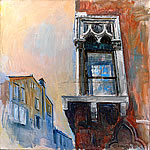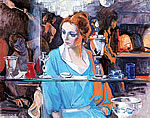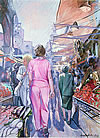| |
|
|
 |
|
| A painter, Venice and its people * |
|
|
|
|
|
|
| |
|
|
|
|
|
|
|
|
|
|
| |
|
by Guido Perocco |
|
|
|
|
|
|
| |
|
|
|
|
|
|
|
|
|
|
| |
|
|
|
|
|
|
|
|
|
|
 |
| |
| Venetian gothic, 1987 |
|
|
There are some Venetian artists whom, whatever
story their painting may tell, including the lives of the saints, always
keep in mind Venice and something which belongs exclusively to it.
Ernani Costantini is among these: his painting always reflects “something
which belongs to his city”. Even more so now in such an important
cycle as this, totally dedicated to the Venice of yesterday and today
along with the theatre of its people. The city of yesterday is present
with its traditional masks, that of today is represented by the colourful
summer clothes, carefree and fanciful.
One is immediately struck by the spontaneous and direct feel to this
lovely series of paintings by Ernani Costantini, who has reached a
particularly satisfying point in his artistic expression: the hint of
a fresco are immediately apparent, the joy of
a large fresco, with the charming ‘timbre’ of
its bright colours.
Last year the artist presented From Eve to Mary – twelve
female figures from the Bible –, a collection of large images
of vast resonance, both exquisite and evocative; this year the splendid
exhibition which is shortly to be inaugurated, dedicated to Living
in Venice.
The artist arrived at this style in stages: he is an outstanding expert
of ancient art, and has studied Impressionism in great depth, he tends
naturally towards some Art Noveau
inventiveness,
he has subsequently reflected on the most up-to-date trends in art,
without overlooking abstract painting. On the other hand he has been
capable of absorbing a certain neorealism which has come from the cinema,
from the intelligent cut of his composition which is informed by real
life, the significant fragment chosen from among the vast choral chant
of visual appearances. Ernani Costantini also touches and measures
reality scrupulously, while granting a sense of spiritual anticipation
to the atmospheric phenomena, transfiguring them into high poetry.
|
|
|
| |
|
One immediately perceives that love is
present in the chosen theme; his Venice is the fruit of the maturation
of a long reflection, at the right moment, after much work. Without
fearing awkward parallels, the artist has been able to look, for example,
toward the admirable heights of Canaletto in the eighteenth century,
the affectionate assurance of Giacomo Favretto in the nineteenth century,
the rich spontaneity of the poetic inspiration of Alessandro Milesi
between the nineteenth and twentieth centuries, up to and including
the top artists of the latest generation. Each of them, in his own
way, was in love with the same subject and explored in their mind its
most evocative expression.
Ernani Costantini has made use first of all of the airy breath of his colours,
in an open and unfolding song, which finds in water its closest correspondence,
a transparent light, blown by the wind, as the artist prefers, in which architectural
shapes appear clearer. The underlying graphic clarity is thus attained, which
typifies his image of reality.
|
|
 |
| |
| Olga K. in Murano, 1988 |
|
 |
| |
| Comings and goings at the jetty…, 1987 |
|
|
Venice is not only the city of famous views,
it is also that of remote canals, little squares, bridges, rows of
houses along the canal paths, or also
that of unexpected sights: gothic windows of extraordinary elegance,
the backgrounds to scenes, short films, it seems almost without realizing,
which reveal the city’s mysterious secret.
It is here, in this quaint web of an ancient city,
that Ernani Costantini is not afraid to meet people in the streets and indoors,
on the stage of venetian theatre: the beautiful lady admiring the artistic glass
in a factory in Murano, another who sits at a cafè with
the St. Mark’s Basin in the background,
others who hurry towards the ‘vaporetto’ jetty.
This, in my opinion, is the newest and most innovative part of the exhibition.
|
|
|
| |
|
We must look carefully then: and here is the great scene
of the Rialto market: the harlequin crowd in modern clothes, the shop
blinds against the embroidery of the sky, the, le ‘still life’ on
the fish and fruit stalls. Then in the distance, the group of happy
girls on the steps of the bridge. The bell tower, the façade
of a church, an architectural outline or other stupendous glimpses
along the way give this multitude a very special character: the air
of Venice. In this celebration there is a hint of Favretto in the nineteenth
century costume: the people who gave life to the stones of Venice,
especially the lovely ordinary womenfolk, in their shawls and long
dresses.
The theatre of the eighteenth century however, is represented by a more aristocratic costume;
everyone is masked: Brighella, Rosaura, the Zanni (so close to images by Giandomenico
Tiepolo) all playing their part. Ernani Costantini gives each one its own character
of today, thereby proving his dominance of figures and landscapes in such a difficult
and arduous theme which nevertheless flows from his brush like a song.
It is Venice’s ancient spell translated into painting. |
|
 |
| |
| In Rialto, 1987-88 |
|
| |
|
|
|
|
|
|
|
|
|
|
| |
|
|
|
|
|
|
|
|
|
|
| |
|
*^ From the catalogue
of the exhibition Vivere a Venezia [Living in Venice] |
|
|
| |
|
|
|
|
|
|
|
|
|
|
| |
|
|
|
|
|
|
|
|
|
|
| |
|
|
|
|
|
|
|
|
|
|
| |
|
|
|
|
|
|
|
|
|
|
| |
|
|
|
|
|
|
|
|
|
|
| |
|
|
|
|
|
|
|
|
|
|
 |
 |
 |
 |
 |
 |
 |
 |
 |
 |
 |
|

